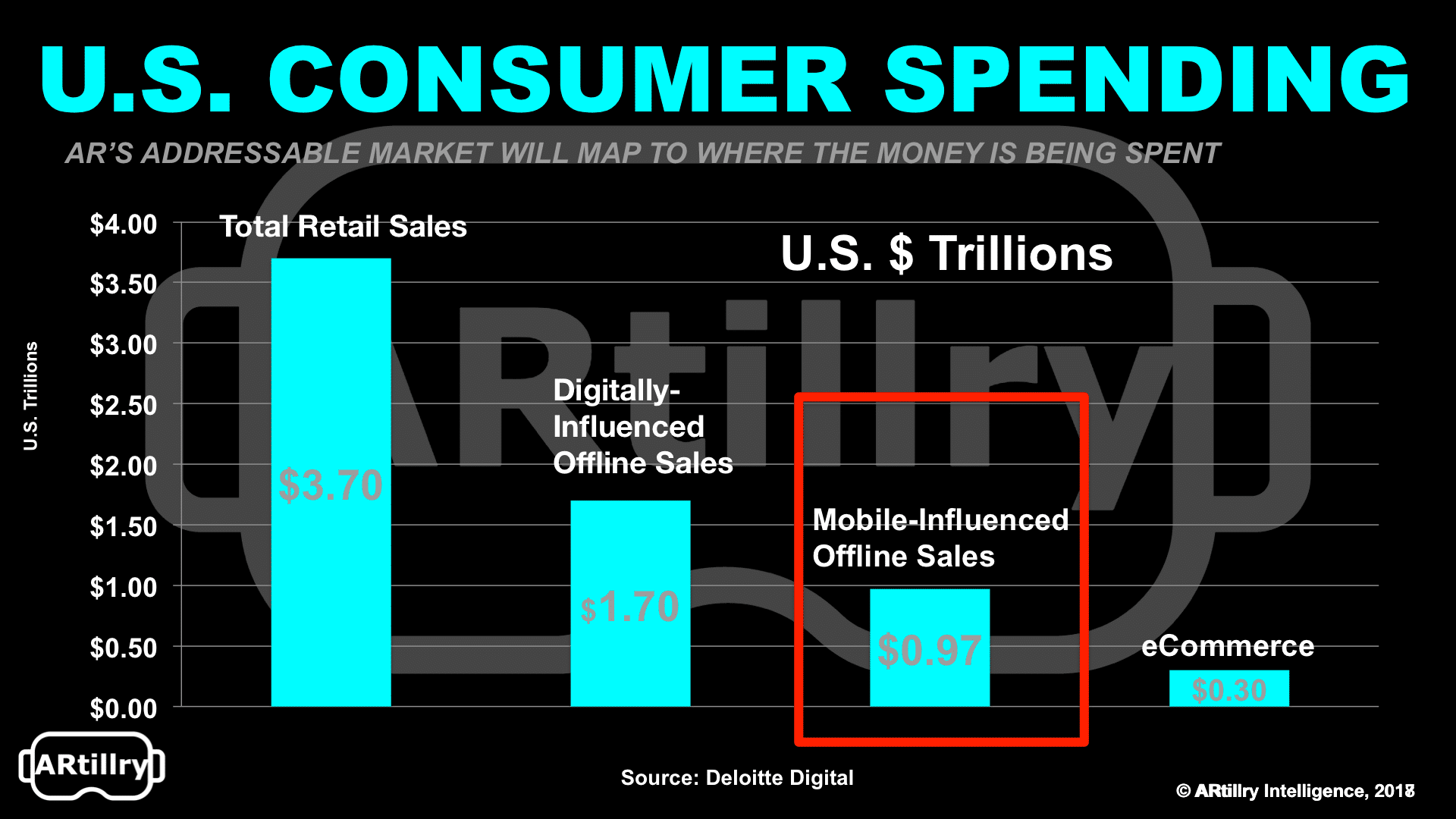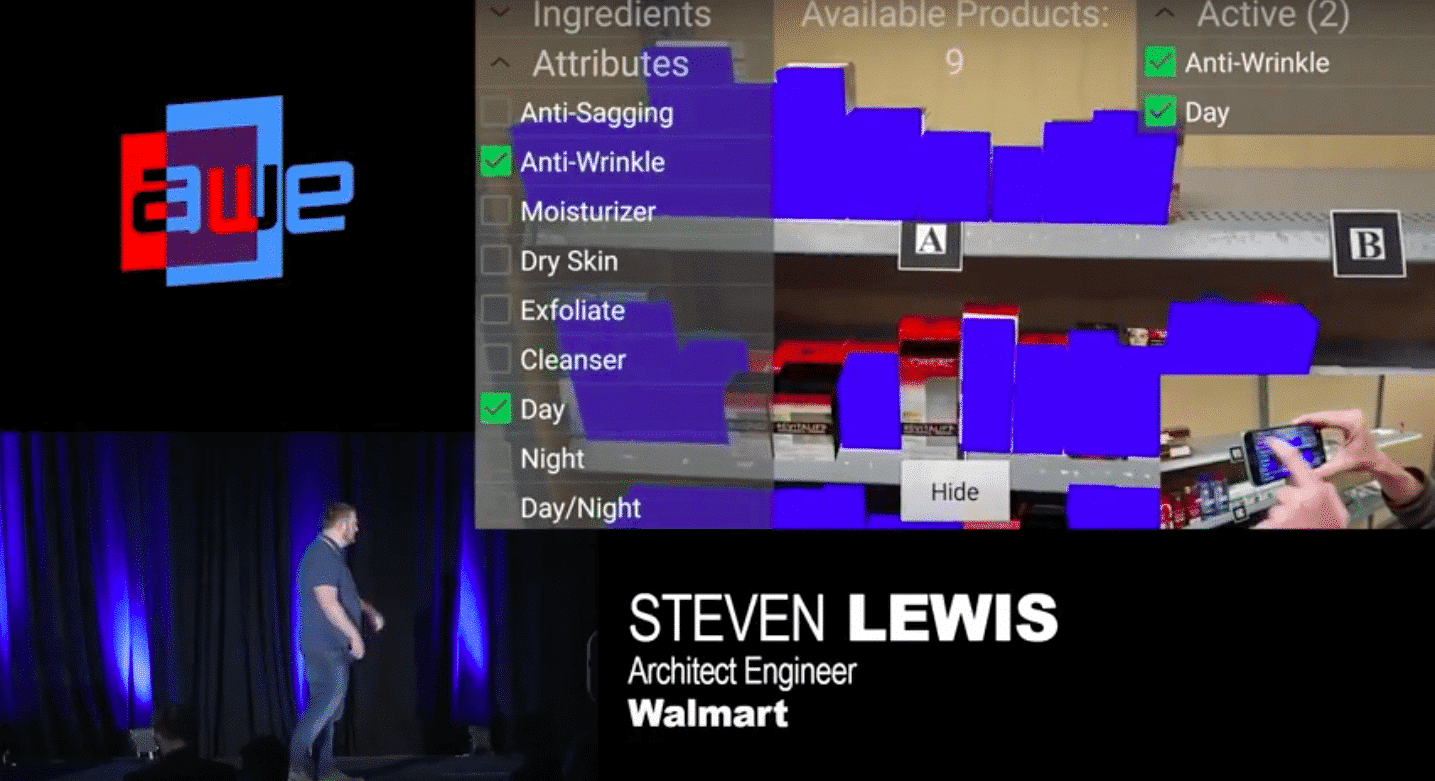
Will AR Bring Together the Best of Online and Offline Shopping?
Among the cultural and commercial sectors that AR will transform, shopping could have the most significant economic impact. AR is already making its mark in e-commerce through product visualization tactics being used by brands like IKEA and BMW. But could it do even more in brick-and-mortar shopping?
It’s often forgotten that e-commerce represents a small share of retail spending. Of the $3.7 trillion spent in the U.S., about $3.4 trillion is in physical stores. But it’s important to note that online and mobile media increasingly drive and influence that offline spending, to the tune of about $2 trillion.
And that’s where AR will come in. It’s well-suited for qualifying products in the physical world through informational overlays. Holding up your phone is more intuitive than typing words into Google or Amazon in a store aisle. And camera affinity is strong among millennials and Gen Z.

The best way to think about AR’s utility in retail is fusing the best of e-commerce and in-store experiences. The reasons offline shopping dominates include immediate gratification and the need to see/touch products—especially big-ticket items like TVs, cars, and couches.
But what about the advantages of e-commerce? There’s more supply, transparency, cost efficiency, inventory (a.k.a “endless aisle”) and ability to dynamically search and filter product attributes. AR can engender a sort of hybrid UX that brings these features to store aisles.
One example is Walmart, which built an AR prototype app to assist in-aisle product engagement. When pointed at a shelf of cosmetic products—an SKU-intensive category—the app filters attributes like price and color, just like an e-commerce UX. It then highlights items that match the filter criteria (see image below).
“When I say ‘physical to digital’ I mean it literally: smash them together,” said Walmart’s Steven Lewis in reference to the app, on stage at AWE in June. “You choose filter criteria, and it narrows down and filters out what you don’t want to see. That’s kind of like an e-commerce experience.”

Since Lewis’ AWE comments, Walmart has taken this to another level. Its recently launched AR Scanner app feature lets users point their phones at products while in-store (see video below). This dynamically invokes informational overlays such as product details, pricing, reviews, and so on. It has the makings of true in-store utility.
But beyond the benefits to users—which of course drive repeat business and ARPU metrics for retailers—there are direct retailer benefits. For example, the AR in-aisle engagement uncovers shopping data that informs everything from inventory management to optimal store layouts.
“There’s lots of analytics you can get as a retailer or brand when you actually have someone with a mobile device, or headset in the future, looking at your products,” said Lewis. “Retailers today try to guess your dwell time … there could be a whole lot of [AR] analytics that would be helpful.”
For example, one of the benefits and drivers for Google’s VPS is to report/attribute in-store sales to advertisers to validate their ROI. This last mile to the cash register has always been a gray area in ad effectiveness despite the fact that it, again, is where most spending happens.
AR in retail will also be the latest evolution in showrooming: using the mobile device’s connectivity and portability to inform in-store purchases (or order online). And just like showrooming over the past decade, the losers in the next era of retail will be those who try to fight it.
We’re currently seeing lots of examples of this “adapt or die” principle with retailers embracing digital disruption. There’s a growing divergence in the retail sector where digital converts are thriving and exceeding quarterly revenue targets, while non-adaptive companies are dying.
The former include companies like Target and Walmart that are innovating with in-store digital shopping tools, mobile payment,s and order/pick-up features. The latter include companies like Toys ‘R Us and Circuit City that failed to embrace mobile tech and millennial proclivities.
The next step in that trend will be AR and other flavors of in-store digitization—like our longstanding prediction for in-aisle payments that’s finally materializing with Amazon Go and a few others. Retailers will have to keep up if they’d like to control their own destinies. If not, someone else will.
Bottom line: Amazon is closing the gap on e-commerce disadvantages (with things like AR product visualization). So retail stores that fail to likewise close the gap on the disadvantages of in-store shopping (with things like in-aisle AR, payments, etc.) will lose the battle for retail’s next era.
Mike Boland is Street Fight’s lead analyst, author of the Road Map column, and producer of the Heard on the Street podcast. He covers AR & VR as chief analyst of ARtillry Intelligence and SF President of the VR/AR Association. He has been an analyst in the local space since 2005, covering mobile, social, and emerging tech.
Header image credit: Lowes


